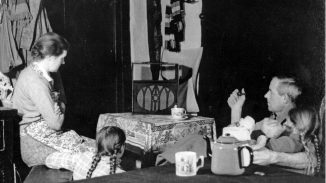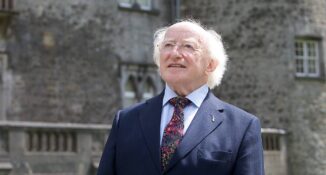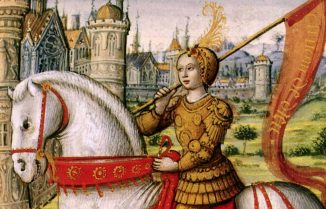80 years ago today, the inaugural hearing of the International Court of Justice (ICJ) also called the World Court, was held at the Peace Palace in The Hague, The Netherlands. The ICJ is the highest legal authority in the sphere of international law, but despite this most prestigious position, its decisions are unenforceable without mandates from the UN to pursue them. As a result, its history has been made up of landmark decisions that have altered the conduct of nations for decades, as well as decisions that are ignored and forgotten faster than the average news bulletin. READ how it shapes international behavior… (1946)

A perfect example of the difficulties inherent in the institution, the first-ever case heard in the ICJ was the Corfu Channel case of 1947, where Great Britain sought reparations for lives lost and damage to Royal Navy ships when they were passing through the Corfu Channel and were fired upon by Albanian shore batteries and struck marine minefields allegedly laid by Albania.
The court ruled that the Albanian charge that the UK flotilla was passing illegally through her own territorial waters was invalid since international straits facilitate navigation at the point where two bodies of territorial waters or international waters end. £843,947 was ruled should be paid to the UK—a sum which went uncollected due to the court’s lack of enforcement mechanism until 1996, when the UK was able to confiscate two tons of Nazi gold.
While the ruling itself was unenforced, and the UK went without compensation for 50 years, the case did enshrine the concept of “innocent passage” whereby ships, including those equipped for war, at times have no choice but to traverse archipelagic waters, straits, and other maritime features controlled by nations, and should therefore be allowed passage within reasonable limits of security enforcement.
One can see then that the ICJ has a strange sort of influence on our global society.
The ICJ has been in the news recently for ruling that there is probable cause to believe Israel is committing the crime of genocide in Gaza, the first such decision against Israeli, who have never recognized the court’s jurisdiction or decisions, in its history.
MORE Good News On This Day:
- Zimbabwe celebrates Independence Day (1989)
- Green Cross International was co-founded by former USSR President Mikhail Gorbachev to protect the global environment which transcends national borders (1993)
- Wayne Gretzky, the National Hockey League’s all-time leading scorer, played his final professional game, at Madison Square Garden (1999)
- Sir Elton John raised $700,000 for his AIDS charity by selling over 10,000 pieces from his own wardrobe at a one-time shop in New York City’s Rockefeller Center called, “Elton’s Closet” (2006)
On this day 101 years ago, Yankee Stadium opened its doors in The Bronx for the first time with John Philip Sousa playing The Star-Spangled Banner. Slugger Babe Ruth hit a home run to help defeat his former team, the Boston Red Sox, on the spring opening day of Major League Baseball season. Called “The House that Ruth Built” it has often been referred to as “The Cathedral of Baseball.”

In baseball terms, across its 86 years of existence, Yankee Stadium hosted 6,581 regular season home games for the Yankees. Only Fenway Park (Boston), Wrigley Field (Chicago), Sportsman’s Park (St. Louis), and Tiger Stadium (Detroit) have hosted more games. Due to the Yankees’ frequent appearances in the World Series, Yankee Stadium played host to 161 postseason games, more than any other stadium in baseball history. All three perfect games thrown by Yankee pitchers have occurred at the Stadium.
Yankee Stadium was also home to plenty of huge boxing events, with early legends like Benny Leonard, Jack Dempsey, and Sugar Ray Robinson all winning titles on the diamond.
Perhaps the most famous boxing match ever held at Yankee Stadium was on June 22, 1938, when Joe Louis, an African-American, squared off against Max Schmeling, a German. Adolf Hitler followed the rematch carefully, imploring Schmeling to defeat Louis, whom Hitler publicly berated. This left some with what they perceived as a moral predicament: root for the black fighter, or for the Nazi.
President FDR called Louis the day before the fight and explained to him that the nation was counting on him to beat Schmeling. History has shown Schmeling was anything BUT a Nazi, and in fact saved the lives of Jewish children. On the day of the fight, the “Brown Bomber” Louis knocked out Schmeling in the first round, disproving Hitler’s vision of a sporting demonstration of Aryan superiority.
Also disproving Hitler’s theory that African-Americans were only good for their power, Louis’ punches were extremely short and precise, and he stalked Schmeling everywhere he went with a level of composure that seemed impossible considering the build-up to the fight.
Yankee Stadium hosted its final baseball game on September 21, 2008. With Andy Pettitte as the starting pitcher, the Yankees played their final game at Yankee Stadium against the Baltimore Orioles, recording the final out at 11:43 pm EDT in a 7–3 Yankee victory.
Among many ‘lasts’ to be recorded, a long-time standing question was answered. It was first wondered by Babe Ruth after he hit the first home run in Yankee Stadium on its opening day.
“I was glad to have hit the first home run in this park,” Ruth said. “God only knows who will hit the last.” That player turned out to be Yankees backup catcher José Molina, as he hit a go-ahead and eventual game-winning two-run home run in the fourth inning. (1923)
94 years ago today, a magical thing happened that in today’s epoch of 24-hour news cycles seems both impossible and almost noble. At a quarter to the hour of nine, a BBC news announcer told the British public “there is no news,” and played piano music instead for the 15-minute interval before the next bulletin reported on the curtain raising of the Wagner opera Parsifal, which was being performed at Queen’s Hall in Langham Place. (1930)

Far from the nation’s radio broadcaster deciding that no news was worth reporting on, which would be as eerie as it would be hilarious, news was a different industry in those days. Government press releases and advisories made up the vast majority of news bulletins reported on by radio news, while an embargo of daylight operating hours to protect the newspaper industry meant they got all stories last, often hours or days after they had broken.
April 18th, 1930 fell on Good Friday, so many regional news feeds and newspapers that would go into the national bulletin feed were closed for the day. Expecting to receive a denial from the home secretary over an interview controversy, the BBC had to resort to piano music when, considering that newspapers were printing on Good Friday, the Home Secretary’s office didn’t release anything. WATCH a video explaining the intimate details of this unthinkable event…
Happy 83rd Birthday to Michael D. Higgins, the poet, sociologist, and ninth president of Ireland since 2011.
Coming from a broken home in Limerick, Higgins learned compassion and used his time in office to address issues concerning justice, social equality, inclusion, anti-sectarianism, anti-racism, and reconciliation.

He made the first state visit by an Irish president to the United Kingdom in 2014, staying as a guest of the Queen at Windsor Castle and addressing both Houses of Parliament. He also served as Minister for Arts and Culture, Mayor of Galway, and was a senator from 1973 to 1977.
Higgins ran for a second term as President of Ireland in 2018 and was re-elected in a landslide victory, having attained the largest personal mandate in the history of the Republic of Ireland.
As a poet, Higgins has written for a number of periodicals, as well as publishing four collections of his poetry, including The Betrayal, The Season of Fire, and his latest 2004 book, An Arid Season. (1941)
249 years ago, Paul Revere, who was 40 years old at the time, a respected craftsman and father of 16 children, rode with William Dawes and Samuel Prescott, galloping through the countryside of colonial Massachusetts to Lexington and Concord warning of the sudden movements of the British army (1775)
Contrary to myth, Revere did not shout, “the British are coming” (he himself was British). Instead, he spread the word by shouting, “The regulars are out.”
Two lanterns were hung in the Old North Church of Boston indicating the army’s choice to approach by crossing the Charles River. Dawes and Revere rode on different paths toward Lexington to warn John Hancock and Samuel Adams of their likely arrest. Prescott happened to be on the road at 1:00 AM on April 19 when he met Revere and Dawes and joined them on their ride to Concord to forewarn of the British intention to seize the weapons cache there. Although he joined the ride late, he was the only one of the three men to reach Concord and warn the town. He then proceeded further west to warn Acton, Massachusetts, while his brother Abel rode south to warn Sudbury and Framingham.
Revere’s rapid warning served to alert the region’s “Minutemen” in time for them to engage the British Army at the Battle of Lexington and Concord on April 19–and fire, what would be called, “the shot heard round the world.” (1775)

And, 115 years ago today, Joan of Arc was beatified as a saint by Catholic leaders in Rome. An illiterate farm girl who claimed that the voice of God instructed her to take charge of France’s army and lead it to victory by driving out the English, she was viewed as the only source of hope for a regime that was near collapse during the end of the Hundred Years’ War. Charles VII sent Joan to the siege of Orléans as part of a relief army after she successfully predicted a military reversal several days before messengers arrived to report it. She was found pure of motive and traveled through hostile territory disguised as a male soldier. What followed was even more surprising.
Within only nine days she turned the tide of the siege. Several additional swift victories lifted the teen to prominence and led to Charles VII’s coronation as king. This long-awaited event boosted French morale and paved the way for the final French victory. She was captured in battle, put on trial by the English, and burned at the stake at age 19. The ability of this peasant girl to defeat their armies was regarded as proof that she was possessed by the Devil. WATCH a video below, except it gives an incorrect date for her beatification. (1909)
SHARE the Milestones, Memories, and Music…




















